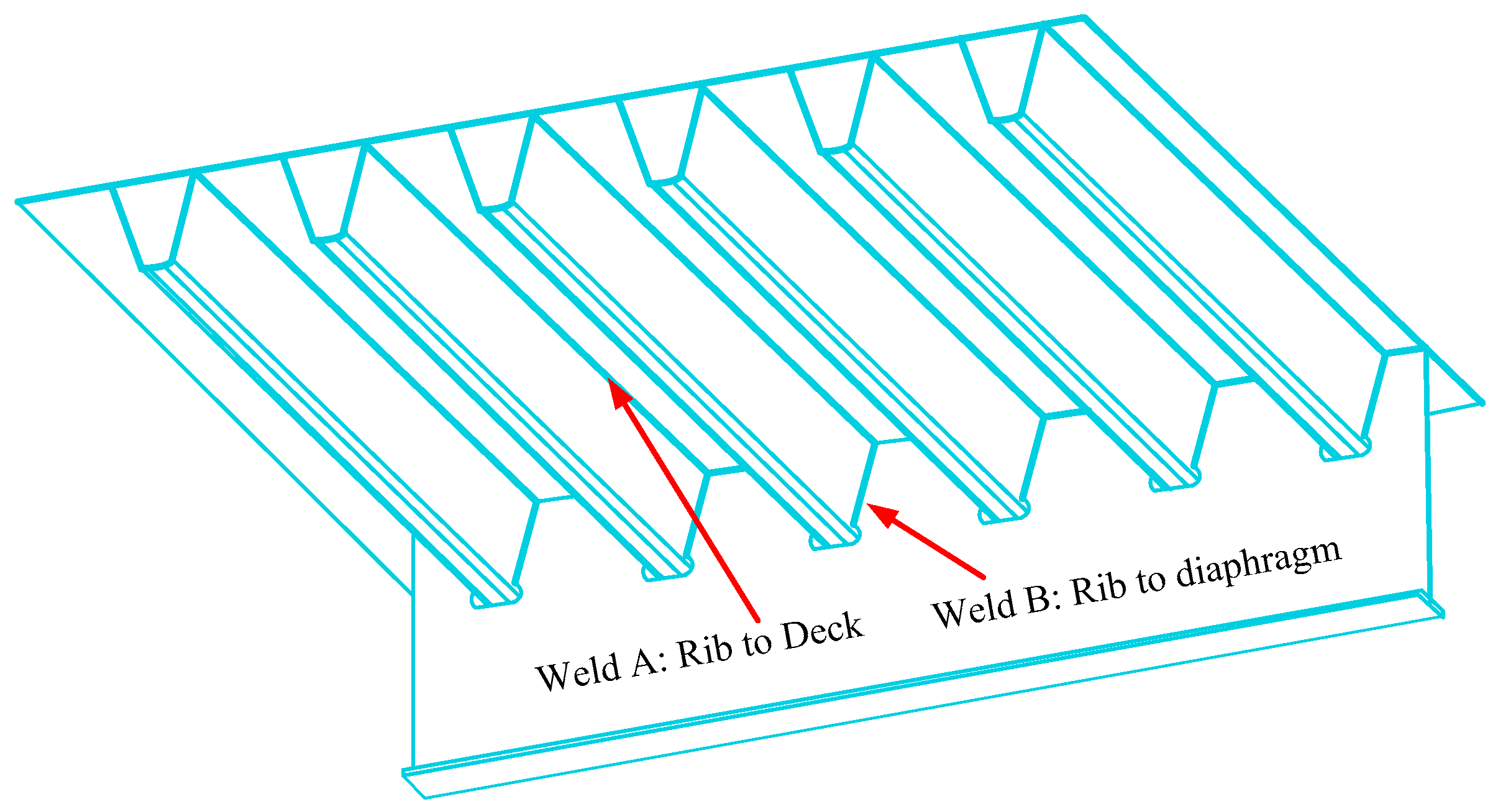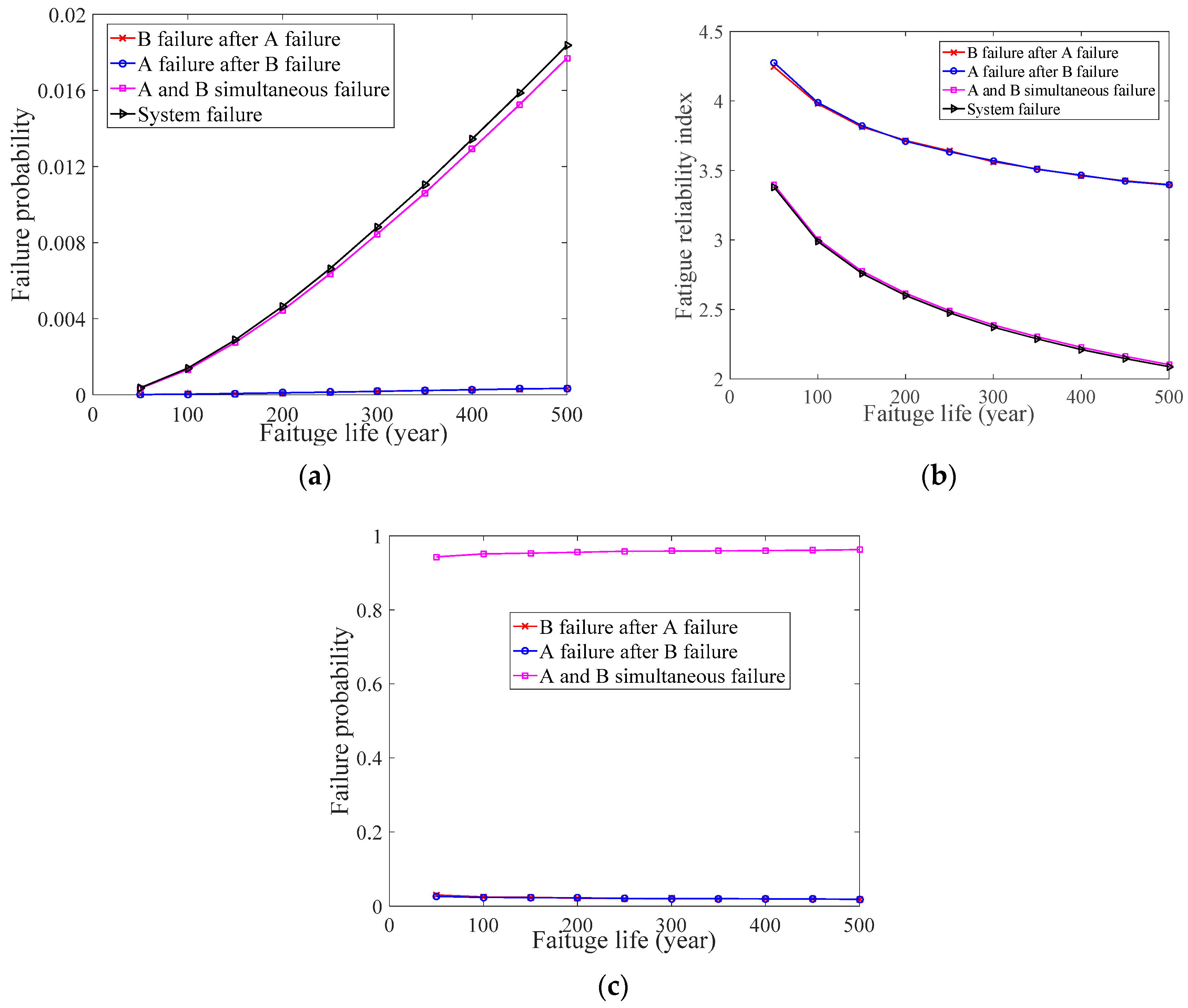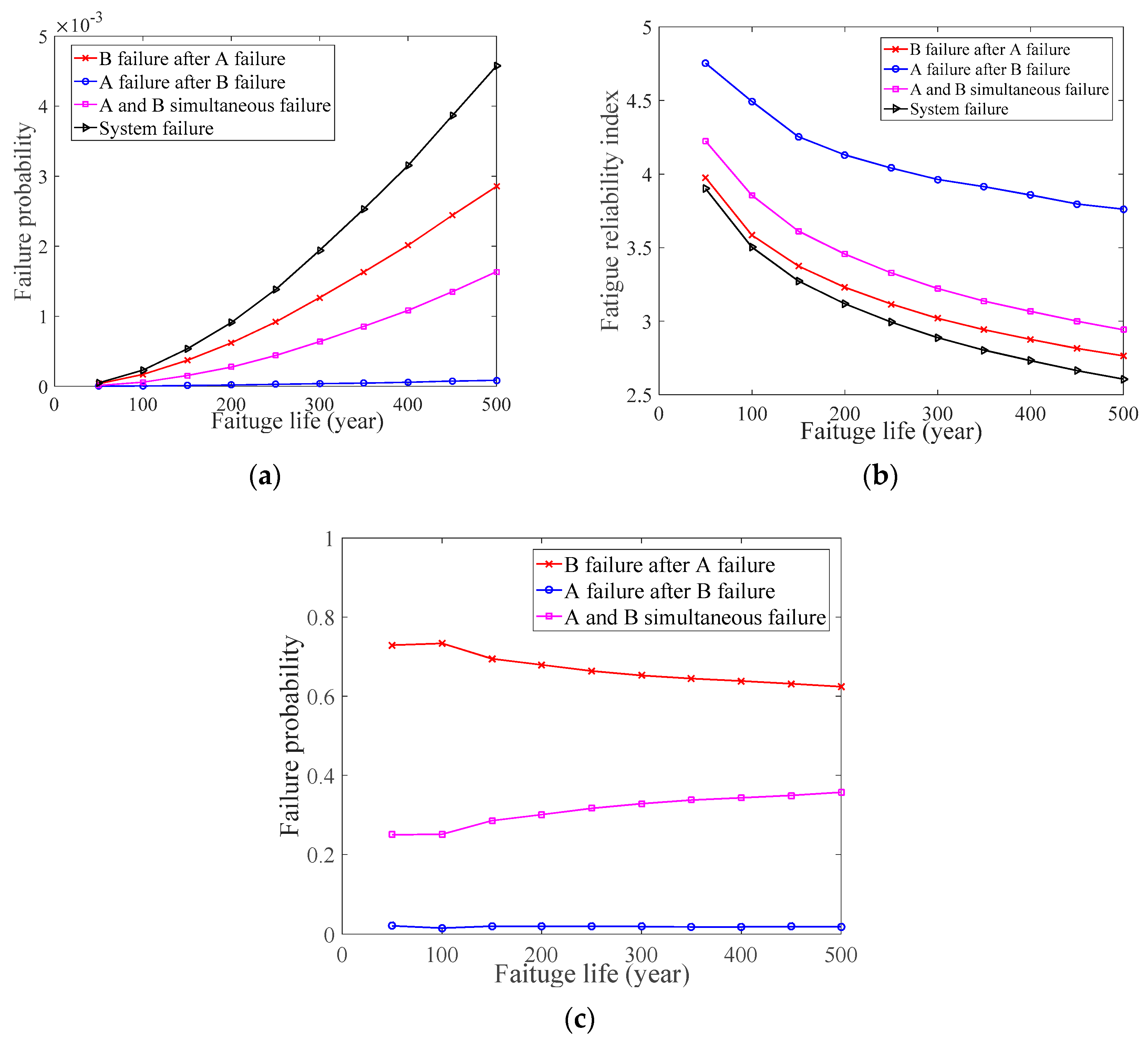Failure Evaluation of Bridge Deck Based on Parallel Connection Bayesian Network: Analytical Model
Abstract
:1. Introduction
2. Development of Bayesian Network for the BD at System Level
2.1. Probabilistic Model of Fatigue Reliability
2.2. Construction of the Bayesian Network for the BD
P(S = 1 | A = 0, B = 1) = 0
P(S = 1 | A = 1, B = 1) = 1
2.3. Computation Algorithm of the Proposed Bayesian Network
3. Numerical Case Study
4. Conclusions
Author Contributions
Funding
Institutional Review Board Statement
Informed Consent Statement
Data Availability Statement
Conflicts of Interest
Appendix A
- C is constant for a given material, C = 19,930.2;
- is the stress amplitude (SA);
- N is the total cycle number (CN);
- ni is the CN for the nth cycle;
- f(Se) is the expression of the SA;
- ntot is the total CN.
- t is service life;
- Df follows the lognormal distribution LN (0, 0.294);
- pf is the fatigue failure probability;
- β is fatigue reliability index;
- Dfi is the failure damage of the weld i;
- x is an unknown parameter;
- g(x) is the function of x;
- p(x) is the target function of x;
- E[] is the mathematical expectation.
References
- Gou, H.; Wang, W.; Shi, X.; Pu, Q.; Kang, R. Behavior of steel-concrete composite cable anchorage system. Steel Compos. Struct. 2018, 26, 115–123. [Google Scholar]
- Zhang, Q.; Liu, Y.; Bao, Y.; Jia, D.; Bu, Y.; Li, Q. Fatigue performance of orthotropic steel-concrete composite deck with large-size longitudinal u-shaped ribs. Eng. Struct. 2017, 150, 864–874. [Google Scholar] [CrossRef]
- Cui, C.; Bu, Y.; Bao, Y.; Zhang, Q.; Ye, Z. Strain energy-based fatigue life evaluation of deck-to-rib welded joints in OSD considering combined effects of stochastic traffic load and welded residual stress. J. Bridge Eng. 2018, 23, 04017127. [Google Scholar] [CrossRef]
- Fisher, J.W.; Roy, S. Fatigue of steel bridge infrastructure. Struct. Infrastruct. Eng. 2011, 7, 457–475. [Google Scholar] [CrossRef]
- Fisher, J.W.; Barsom, J.M. Evaluation of cracking in the rib-to-deck welds of the bronx-whitestone bridge. J. Bridge Eng. 2016, 21, 04015065. [Google Scholar] [CrossRef]
- Fu, Z.; Ji, B.; Zhang, C.; Wang, Q. Fatigue performance of roof and u-rib weld of orthotropic steel bridge deck with different penetration rates. J. Bridge Eng. 2017, 22, 04017016. [Google Scholar] [CrossRef]
- Sony, S.; Laventure, S.; Sadhu, A. A literature review of next-generation smart sensing technology in structural health monitoring. Struct. Control Health Monit. 2019, 26, e2321. [Google Scholar] [CrossRef]
- Wang, M.L.; Yim, J. Sensor enriched infrastructure system. Smart Struct. Syst. 2010, 6, 309–333. [Google Scholar] [CrossRef]
- Mufti, A.A. Structural health monitoring of innovative Canadian civil engineering structures. Struct. Health Monit. 2002, 1, 89–103. [Google Scholar] [CrossRef]
- Yun, C.B.; Lee, J.J.; Koo, K.Y. Smart structure technologies from civil infrastructures in Korea: Recent research and applications. Struct. Infrastruct. Eng. 2011, 7, 673–688. [Google Scholar] [CrossRef]
- Pines, D.J.; Aktan, A.E. Status of structural health monitoring of long-span bridges in the United States. Prog. Struct. Eng. Mater. 2002, 4, 372–380. [Google Scholar] [CrossRef]
- Liu, M.; Frangopol, D.M.; Kwon, K. Fatigue reliability assessment of retrofitted steel bridges integrating monitored data. Struct. Saf. 2010, 32, 77–89. [Google Scholar] [CrossRef]
- Kulkarni, S.S.; Achenbach, J.D. Structural health monitoring and damage prognosis in fatigue. Struct. Health Monit. Int. J. 2008, 7, 37–49. [Google Scholar] [CrossRef]
- Deng, Y.; Liu, Y.; Feng, D.; Li, A. Investigation of fatigue performance of welded details in long-span steel bridges using long-term monitoring strain data. Struct. Control Health Monit. 2015, 22, 1343–1358. [Google Scholar] [CrossRef]
- Singh, S.P.; Mohammadi, Y.; Goel, S.; Kaushik, S.K. Prediction of mean and design fatigue lives of steel fibrous concrete beams in flexure. Adv. Struct. Eng. 2007, 10, 25–36. [Google Scholar] [CrossRef]
- Oh, H.B. Fatigue analysis of plain concrete in flexure. J. Struct. Eng. 1986, 112, 273–288. [Google Scholar] [CrossRef]
- Ye, H.; Shuai, C.; Zhang, X.; Xu, X.; Ummenhofer, T. Determination of S-N fatigue curves for damaged steel plates strengthened with prestressed CFRP plates under tension loading. Eng. Struct. 2018, 175, 669–677. [Google Scholar] [CrossRef]
- Cui, C.; Xu, Y.L.; Zhang, Q.H.; Wang, F.Y. Vehicle-induced fatigue damage prognosis of orthotropic steel decks of cable-stayed bridges. Eng. Struct. 2020, 212, 110509. [Google Scholar] [CrossRef]
- Jiang, L.; Liu, Y.; Fam, A.; Wang, K. Fatigue behaviour of non-integral y-joint of concrete-filled rectangular hollow section continuous chord stiffened with perfobond ribs. Eng. Struct. 2019, 191, 611–624. [Google Scholar] [CrossRef]
- Zhu, S.P.; Liu, Q.; Lei, Q.; Wang, Q. Probabilistic fatigue life prediction and reliability assessment of a high pressure turbine disc considering load variations. Int. J. Damage Mech. 2017, 27, 1569–1588. [Google Scholar] [CrossRef]
- Haririardebili, M.A.; Sudret, B. Polynomial chaos expansion for uncertainty quantification of dam engineering problems. Eng. Struct. 2020, 203, 109631. [Google Scholar] [CrossRef]
- Pardo-lgúzquiza, E. Bayesian inference of spatial covariance parameters. Math. Geol. 1999, 31, 47–65. [Google Scholar] [CrossRef]
- Ni, Y.Q.; Wang, Y.W.; Zhang, C. A Bayesian approach for condition assessment and damage alarm of bridge expansion joints using long-term structural health monitoring data. Eng. Struct. 2020, 212, 110520. [Google Scholar] [CrossRef]
- Chiachio, M.; Chiachio, J.; Rus, G.; Beck, J.L. Predicting fatigue damage in composites: A Bayesian framework. Struct. Saf. 2014, 51, 57–68. [Google Scholar] [CrossRef] [Green Version]
- Zhang, R.X.; Mahadevan, S. Model uncertainty and Bayesian updating in reliability-based inspection. Struct. Saf. 2000, 22, 145–160. [Google Scholar] [CrossRef]
- Thanh-Binh, T.; Emilio, B.A.; Younes, A. A dynamic Bayesian Network framework for spatial deterioration modelling and reliability updating of timber structures subjected to decay. Eng. Struct. 2020, 209, 110301. [Google Scholar]
- Gehl, P.; D’Ayala, D. Development of Bayesian Networks for the multi-hazard fragility assessment of bridge systems. Struct. Saf. 2016, 60, 37–46. [Google Scholar] [CrossRef]
- Yazdani, A.; Shahidzadeh, M.; Takada, T. Bayesian Networks for disaggregation of structural reliability. Struct. Saf. 2020, 82, 101892. [Google Scholar] [CrossRef]
- Dong, P. A structural stress definition and numerical implementation for fatigue analysis of welded joints. Int. J. Fatigue 2001, 23, 865–876. [Google Scholar] [CrossRef]
- Kyuba, H.; Dong, P. Equilibrium-equivalent structural stress approach to fatigue analysis of a rectangular hollow section joint. Int. J. Fatigue 2005, 27, 85–94. [Google Scholar] [CrossRef]
- Hashin, Z. A reinterpretation of the Palmgren-Miner rule for fatigue life prediction. Int. J. Appl. Mech. 1980, 47, 446–447. [Google Scholar] [CrossRef] [Green Version]
- Wirsching, P.H. Fatigue reliability for offshore structures. J. Struct. Eng. 1984, 110, 2340–2356. [Google Scholar] [CrossRef]
- Bayes, T. An essay towards solving a problem in the doctrine of chances. Philos. Trans. R. Soc. Lond. 1763, 53, 370–418. [Google Scholar] [CrossRef]
- Mahadevan, S.; Zhang, R.; Smith, N. Bayesian networks for system reliability reassessment. Struct. Saf. 2001, 23, 231–251. [Google Scholar] [CrossRef]
- Mirzaei Aliabadi, M.; Aghaei, H.; Kalatpour, O.; Soltanian, A.R.; Nikravesh, A. Analysis of human and organizational factors that influence mining accidents based on Bayesian network. Int. J. Occup. Saf. Ergon. 2020, 26, 670–677. [Google Scholar] [CrossRef]
- Alex, K.; Oswaldo, M.N.; Thomas, Y.; Wim, C.; Johan, M.; Bruno, C. A two-dimension dynamic Bayesian Network for large-scale degradation modeling with an application to a bridges network. Comput. Aided Civ. Infrastruct. Eng. 2017, 32, 641–656. [Google Scholar]
- Geyer, C.J. Practical Markov Chain Monte Carlo. Stat. Sci. 1992, 7, 473–483. [Google Scholar] [CrossRef]
- Andrieu, C.; De Freitas, N.; Doucet, A.; Jordan, M.I. An introduction to MCMC for machine learning. Mach. Learn. 2003, 50, 5–43. [Google Scholar] [CrossRef] [Green Version]




| Numerical Case Study | Welds | Sd | nd | ||
|---|---|---|---|---|---|
| μ | σ | μ | σ | ||
| Numerical case study 1 | A | ln (10) | 0.1 | ln (3000) | 0.05 |
| B | ln (10) | 0.1 | ln (3000) | 0.05 | |
| Numerical case study 2 | A | ln (10) | 0.1 | ln (3000) | 0.05 |
| B | ln (5) | 0.1 | ln (2000) | 0.05 | |
| Numerical case study 3 | A | ln (10) | 0.1 | ln (1000) | 0.05 |
| B | ln (5) | 0.1 | ln (5000) | 0.05 | |
Publisher’s Note: MDPI stays neutral with regard to jurisdictional claims in published maps and institutional affiliations. |
© 2021 by the authors. Licensee MDPI, Basel, Switzerland. This article is an open access article distributed under the terms and conditions of the Creative Commons Attribution (CC BY) license (http://creativecommons.org/licenses/by/4.0/).
Share and Cite
Ding, Y.; Dong, J.; Yang, T.; Zhou, S.; Wei, Y. Failure Evaluation of Bridge Deck Based on Parallel Connection Bayesian Network: Analytical Model. Materials 2021, 14, 1411. https://doi.org/10.3390/ma14061411
Ding Y, Dong J, Yang T, Zhou S, Wei Y. Failure Evaluation of Bridge Deck Based on Parallel Connection Bayesian Network: Analytical Model. Materials. 2021; 14(6):1411. https://doi.org/10.3390/ma14061411
Chicago/Turabian StyleDing, Yang, Jingliang Dong, Tonglin Yang, Shuangxi Zhou, and Yongqi Wei. 2021. "Failure Evaluation of Bridge Deck Based on Parallel Connection Bayesian Network: Analytical Model" Materials 14, no. 6: 1411. https://doi.org/10.3390/ma14061411






